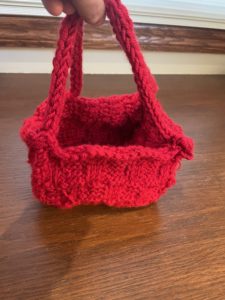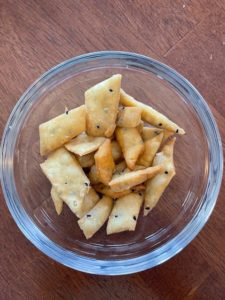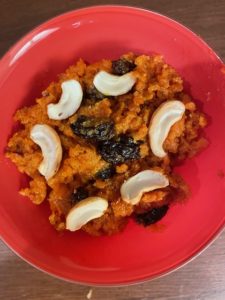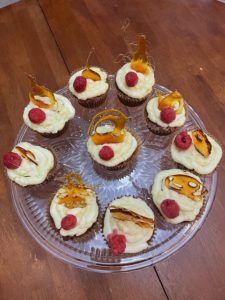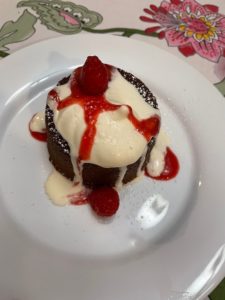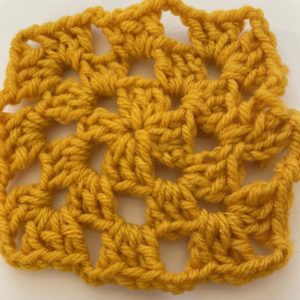Hello there! As you can see from the title, this is about crochet! This Tunisian Crochet basketweave basket is my first design, and I am thrilled to share it with you!
What is Tunisian Crochet? Tunisian Crochet is a type of crochet, that uses a long hook with a knob at the end, kind of like a knitting needle. For crocheting in the round, you would need a double-ended hook or a regular crochet hook with a cable attached to the end. The pattern uses acrylic yarn, even though it is surprisingly sturdy. If you want it to be even more sturdy, you can try using cotton yarn, but it is not necessary. The yarn is a bulky yarn, even though it uses a 5.5mm crochet hook. The reason for this is that it makes the basket extra sturdy. When I say extra sturdy, it is already sturdy from the Tunisian knit stitch base. It has basketweave sides, and it is finished off with 2 I-cords for the handles. This is not the first crochet basket design out there, but there is none I found that used this particular stitch pattern. Tunisian Crochet, yes, but not the particular Tunisian Crochet stitch. This is a small basket, but you can resize it chaining more and doing more rows, just make sure you chain a multiple of 6, since you need that amount in order to crochet the Tunisian Crochet basketweave stitch.
Now, some other variations of this stitch use a multiple of 8 instead, because the ribbing is bigger. I did say ribbing, but the fabric will not be that stretchy, so if you are going do design a pattern that needs to be stretchy, I strongly recommend doing knit ribbing or regular crochet ribbing. If there is a technique for real Tunisian Crochet ribbing, of course you can do that. This is a free pattern, which I am going to share right here.
Tunsian crochet basket weave basket:
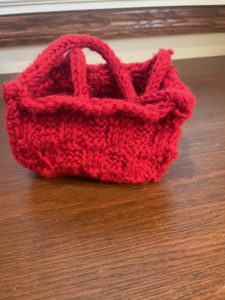
About:
This is a basket made in tunsian crochet. What is tunsian crochet? Tunsian crochet, also known as afghan crochet, is a special type of crochet that uses a special type of hook, either a long hook with a knob at the end for working flat, or a regular hook attached to a cable or alternatively a double-ended hook. The bottom is made from the sturdy tunsian knit stitch, the sides made from the basketweave stitch, and finished of with a I-cord for the handles.
Inspiration:
I had learned about tunsian crochet, and I had learned about the tunsian knit stitch and the basket weave stitch. I had heard that the knit stitch was very stiff. I wondered, why shouldn’t there be a design using these 2 stitches? I looked, but there was no such basket I had found. My original idea was a round basket. Then I realized a double-ended tunsian crochet hook is needed to crochet in the round. I did not want to get this special hook, but I could not leave this idea alone. So I tried to make a circle that worked flat, but all I created was a flower. Then I had the idea to make a square basket, and I designed it.
Construction: First, there is a square for the bottom. Second, you would pick up stitches along 1 of the edges, then work in the basket weave stitch until desired length, repeat. Then, pull the 4 sides up and slip stitch the sides together, and then create 2 I-cords and sew it on to the basket.
Skill Level: Easy
Pattern notes:
- Basket is worked flat
- When I designed this, I had less of a skein of my yarn.
- It calls for a tunsian crochet hook, but you can get away with a regular crochet hook for this project.
- Scissors do not need to be sharp
- If you look the stitches up you will find instructions
- There is some sewing in this project.
- This is a rectangular basket
Techniques/Stitches used
Ch (chain) tks (tunsisian knit stitch) tps ( tunsian purl stitch)
Materials:
1 skein Color Made Easy Yarn Texture (none) weight (200 g) Length (247 yards 226 meters) Thickness (5 or bulky or chunky) Fiber content (100% acrylic)
5.5 mm Tunsian Crochet hook
Tapestry needle
Scissors
Gauge: Make a gauge swatch to check your tension. 16 stitches and 22 rows per “4”
Instructions:
Ch 18. Rows 1-23 tks. Rows 24-27 (tks 3, tps 3,) repeat until end. Rows 27-30 (tps 3, tks 3,) repeat until end. Rows 30-36 repeat rows 24-30. Row 31 (bind off) (tks 1, slip 1,) repeat until end. Pick up stitches along the edges using a crochet hook. Rows 1-3 (tks 3, tps 3,) repeat until end. Rows 3-6 (tps 3, tks 3,) repeat until end. Rows 6-12 repeat rows 1-6. Repeat for all 4 sides. Turn the piece onto the wrong side. Pull all 4 sides up. Slip stitch all 4 sides together. Crochet a I-cord (the one that looks like knit) and sew it on to the basket. Block if desired. Weave in ends.
Here is the pattern! This is my first design, as I had said earlier, so it is my first time writing a pattern, so it may not be that clear. When it say to crochet a I-cord, they are plenty of tutorials on YouTube, and if you look at the I-cord, if you see Vs, and it the tutorial uses a crochet hook, that is the right I-cord. If you want, you can use a diffrent I-cord instead of the one used here. Happy Crocheting!
